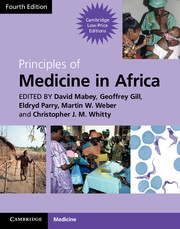Book contents
- Frontmatter
- Contents
- Contributors
- Foreword
- Section 1 Health and disease
- Section 2 Mother and child health
- Section 3 Infection: general principles
- Section 4 Major common infections
- Section 5 Bacterial infections
- 22 Typhoid, paratyphoid and non-typhoid Salmonella infections
- 23 Streptococcus pyogenes and Staphylococcus aureus
- 24 Rickettsial infections
- 25 Brucellosis
- 26 Leptospirosis
- 27 Relapsing fever
- 28 Plague
- 29 Anthrax
- 30 Tetanus
- 31 Diphtheria
- 32 Leprosy
- 33 Cholera
- Section 6 Viral Infections
- Section 7 Protozoal infections
- Section 8 Helminth infections
- Section 9 Fungal infections
- Section 10 Non-communicable diseases
- Section 11 Diseases of body systems
- Section 12 Cancer and Palliative Care
- Section 13 Venoms and Poisons
- Index
- References
22 - Typhoid, paratyphoid and non-typhoid Salmonella infections
from Section 5 - Bacterial infections
Published online by Cambridge University Press: 05 March 2013
- Frontmatter
- Contents
- Contributors
- Foreword
- Section 1 Health and disease
- Section 2 Mother and child health
- Section 3 Infection: general principles
- Section 4 Major common infections
- Section 5 Bacterial infections
- 22 Typhoid, paratyphoid and non-typhoid Salmonella infections
- 23 Streptococcus pyogenes and Staphylococcus aureus
- 24 Rickettsial infections
- 25 Brucellosis
- 26 Leptospirosis
- 27 Relapsing fever
- 28 Plague
- 29 Anthrax
- 30 Tetanus
- 31 Diphtheria
- 32 Leprosy
- 33 Cholera
- Section 6 Viral Infections
- Section 7 Protozoal infections
- Section 8 Helminth infections
- Section 9 Fungal infections
- Section 10 Non-communicable diseases
- Section 11 Diseases of body systems
- Section 12 Cancer and Palliative Care
- Section 13 Venoms and Poisons
- Index
- References
Summary
The problem in Africa
Salmonella infections are among the commonest bacterial isolates from blood cultures throughout Africa. WHO estimates that 12.5 million cases of typhoid fever occur annually world-wide. Most cases are in Asia, but typhoid remains endemic in some areas of Africa, and epidemics are also reported. Invasive non-typhoid salmonella (NTS) infections, a long-standing and common cause of illness and death in African infants and children, have further increased among children and significantly increased among adults as a result of the HIV epidemic.
Whenever an African patient has few signs, yet is ill with a fever, invasive Salmonella infection (either typhoid or non-typhoid) is high on the list of differential diagnoses. Host factors (age, nutrition, malaria, HIV) and local environmental factors will determine whether typhoidal or non-typhoidal disease is most likely. The management of Salmonella sepsis has been complicated by the recent emergence of multidrug resistance.
The organism
Salmonellae are Gram-negative, motile, facultatively anaerobic bacilli, which produce acid on glucose fermentation, reduce nitrates and do not ferment lactose. They can be grown easily on a variety of media. Use of a selective agar, such as XLD or MacConkeys, may be useful if attempting to differentiate them from other organisms, for example, when culturing faeces.
- Type
- Chapter
- Information
- Principles of Medicine in Africa , pp. 308 - 315Publisher: Cambridge University PressPrint publication year: 2013



